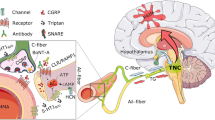Summary
The positive inotropic effect of veratridine and cevadine was investigated in the isolated, isometrically contracting guinea-pig papillary muscle. The increase of the force of the rested-state contraction, elicited after incubation of the resting muscle with veratridine or cevadine, served as a measure of the neurally mediated, sympathomimetic effect of these alkaloids. Concentrations exceeding 5 μmol/l veratridine or 15 μmol/l cevadine produced concentration-dependent increases of the force of the rested-state contraction. These concentrations are larger than those causing the maximum positive inotropic effect on muscles contracting continually at a rate of 1 Hz. The positive inotropic effect of 30 μmol/l veratridine as manifested by the rested-state contraction was absent in the presence of 100 nmol/l tetrodotoxin and in muscles from reserpine-pretreated animals. It was significantly inhibited by 50 nmol/l (−)-propranolol, but not by the same concentration of (+)-propranolol. The effect of 30 or 60 μmol/l cevadine was likewise absent in catecholamine-depleted preparations. It is concluded that the indirect inotropic effect of veratridine or cevadine, which is attributed to their noradrenaline-releasing effect on intracardiac nerves, requires higher concentrations than the direct positive inotropic effect, which is a consequence of the increased transsarcolemmal influx of Na ions into the myocardial cell.
Similar content being viewed by others
References
Akera T, Ku DD, Frank M, Brody TM, Iwasa J (1976) Effects of grayanotoxin I on cardiac Na+, K+-adenosine triphosphatase activity, transmembrane potential and myocardial contractile force. J Pharmacol Exp Ther 199:247–254
Baer M, Best PM, Reuter H (1976) Voltage-dependent action of tetrodotoxin in mammalian cardiac muscle. Nature 263:344–345
Bönisch H, Graefe K-H, Keller B (1980) Reserpine-like, tetrodotoxin-resistant effect of veratridine in the rat vas deferens. Naunyn-Schmiedeberg's Arch Pharmacol 311:R61
Coraboeuf E, Deroubaix E, Tazieff-Depierre F (1975) Effect of toxin II isolated from scorption venom on action potential and contraction of mammalian heart. J Mol Cell Cardiol 7:643–653
Feinstein MB, Paimre M (1968) Mechanism of cardiovascular action of tetrodotoxin in the cat. Circ Res 23:553–565
Fujiwara M, Muramatsu I, Hidaka H, Ikushima S, Ashida K (1979) Effects of goniopora toxin, a polypeptide isolated from coral, on electromechanical properties of rabbit myocardium. J Pharmacol Exp Ther 210:153–157
Honerjäger P (1973) Electrophysiological effects of various ceveratrum alkaloids on single nerve axons. Naunyn-Schmiedeberg's Arch Pharmacol 280:391–416
Honerjäger P (1977) Differentiation of pre- and postsynaptic cardiac effects of steroid alkaloids. Naunyn-Schmiedeberg's Arch Pharmacol 297:R26
Honerjäger P, Reiter M (1975) The relation between the effects of veratridine on action potential and contraction in mammalian ventricular myocardium. Naunyn-Schmiedeberg's Arch Pharmacol 289:1–28
Honerjäger P, Reiter M (1977a) Sarcolemmal sodium permeability and contractile force of guinea pig papillary muscle. Effects of germitrine. Circ Res 40:90–98
Honerjäger P, Reiter M (1977b) The cardiotoxic effect of batrachotoxin. Naunyn-Schmiedeberg's Arch Pharmacol 299:239–252
Horackova M, Vassort G (1973) Ionic mechanism of inotropic effect of veratrine on frog heart. Pflügers Arch 341:281–284
Horackova M, Vassort G (1974) Excitation-contraction coupling in frog heart. Effect of veratrine. Pflügers Arch 352:291–302
Howe R, Shanks RG (1966) Optical isomers of propranolol. Nature (Lond) 210:1336–1338
Koch-Weser J (1966) Myocardial actions of veratrum alkaloids. Abstr 3rd Intern Pharmacol Congr Sao Paulo, No. 505
Moss J, Thoa NB, Kopin IJ (1974) On the mechanism of scorpion toxin-induced release of norepinephrine from peripheral adrenergic neurons. J Pharmacol Exp Ther 190:39–48
Niedergerke R, Ogden DC, Page S (1976) Contractile activation and calcium movements in heart cells. In: Calcium in biological systems, symposia of the society for experimental biology, XXX. Cambridge University Press, Cambridge, pp 381–395
Ravens U (1976) Electromechanical studies of an Anemonia sulcata toxin in mammalian cardiac muscle. Naunyn-Schmiedeberg's Arch Pharmacol 296:73–78
Reiter M (1967) Die Wertbestimmung inotrop wirkender Arzneimittel am isolierten Papillarmuskel. Arzneim Forsch 17:1249–1253
Romey G, Renaud JF, Fosset M, Lazdunski M (1980) Pharmacological properties of the interaction of a sea anemone polypeptide toxin with cardiac cells in culture. J Pharmacol Exp Ther 213:607–615
Ross SB, Kelder D (1979) Release of 3H-noradrenaline from the rat vas deferens under various in vitro conditions. Acta Physiol Scand 105:338–349
Seibel K, Karema E, Takeya K, Reiter M (1978) Effect of noradrenaline on an early and a late component of the myocardial contraction. Naunyn-Schmiedeberg's Arch Pharmacol 305:65–74
Shibata S, Norton TR, Izumi T, Matsuo T, Katsuki S (1976) A polypeptide (AP-A) from sea anemone (Anthopleura xanthogrammica) with potent positive inotropic action. J Pharmacol Exp Ther 199:298–309
Shotzberger GS, Albuquerque EX, Daly JW (1976) The effects of batrachotoxin on cat papillary muscle. J Pharmacol Exp Ther 196:433–444
Thoa NB, Wooten GF, Axelrod J, Kopin IJ (1975) On the mechanism of release of norepinephrine from sympathetic nerves induced by depolarizing agents and sympathomimetic drugs. Mol Pharmacol 11:10–18
Ulbricht W (1969) The effect of veratridine on excitable membranes of nerve and muscle. Ergeb Physiol 61:18–71
Ulbricht W (1974) Drugs to explore the ionic channels in the axon membrane. In: Jaenicke L (ed) Biochemistry of sensory functions. Springer, Berlin Heidelberg New York, pp 351–366
Zlotkin E, Miranda F, Rochat H (1978) Chemistry and pharmacology of Buthinae scorpion venoms. In: Bettini S (ed) Arthropod venoms, handbook of experimental pharmacology, Vol 48. Springer, Berlin Heidelberg New York, p 317–369
Author information
Authors and Affiliations
Additional information
These results were communicated to the Deutsche Pharmakologische Gesellschaft (Honerjäger 1977)
Rights and permissions
About this article
Cite this article
Honerjäger, P. A neurally mediated inotropic effect of veratridine and cevadine on isolated guinea-pig papillary muscle. Naunyn-Schmiedeberg's Arch. Pharmacol. 314, 157–160 (1980). https://doi.org/10.1007/BF00504532
Received:
Accepted:
Issue Date:
DOI: https://doi.org/10.1007/BF00504532




